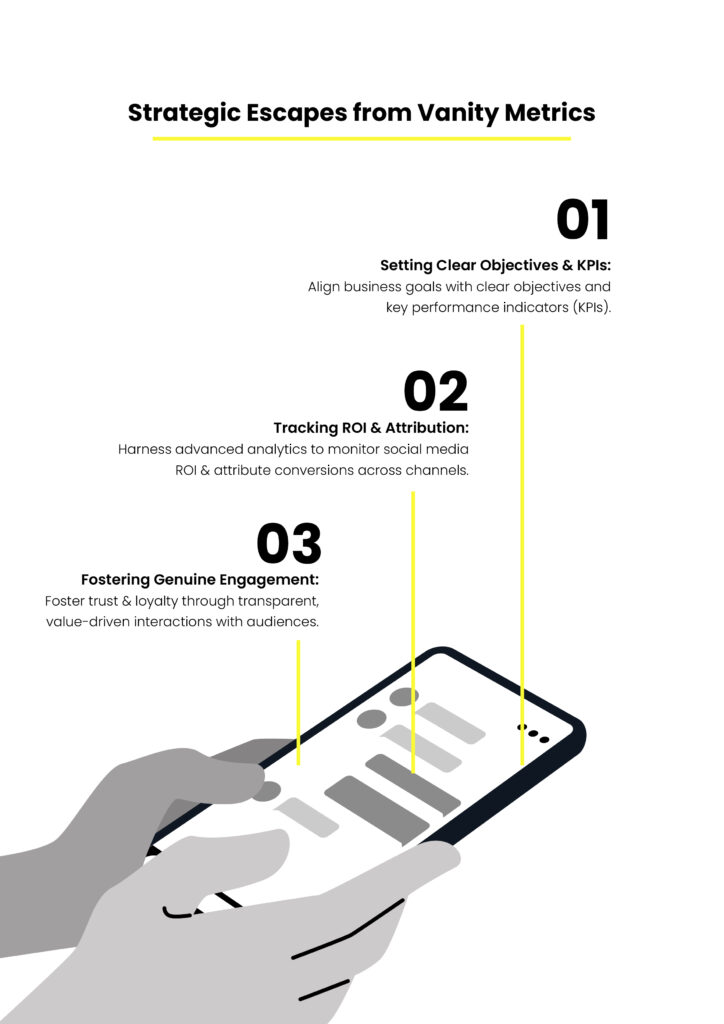In social media marketing, it’s easy to succumb to the allure of numbers. Likes, shares, clicks, and follower counts often dominate, dictating strategies and defining success. Yet, behind the facade of these metrics lies a crucial distinction: the disparity between vanity metrics and those that truly propel growth.
Vanity metrics, captivating in their superficial appeal, often lead marketers astray, fostering a fixation on numbers that fail to translate into meaningful outcomes. Despite their allure, these metrics lack the substance needed to drive genuine progress and align with business objectives.
In this blog, we’ll explore the concept of vanity metrics, unravelling why they captivate many yet frustrate data analysts. We’ll delve into distinguishing between vanity metrics and those of genuine value, equipping you with the insight needed to navigate the complexities of modern marketing.
The Illusion of Success: Understanding Vanity Metrics
Vanity metrics often cast a deceptive shadow over true success. Likes, shares, and follower counts, possess a surface appeal, seemingly indicating progress and popularity. However, beneath this veneer lies a significant discrepancy between appearance and substance.
Consider the case of a burgeoning e-commerce startup celebrating a surge in Instagram followers. While the spike may elicit feelings of triumph, closer scrutiny reveals a majority of these followers to be bots or inactive accounts, offering little in terms of genuine engagement or conversion potential. Similarly, a viral social media post garnering thousands of shares may generate fleeting excitement for a brand, yet fail to translate into tangible business outcomes or sustained customer loyalty.
The psychological impact of vanity metrics on businesses is profound. They often foster a false sense of accomplishment, leading organisations to prioritise metrics that offer little insight into actual performance. This fixation on superficial indicators can divert resources and attention away from strategies that truly drive growth and value.
Limitations of Vanity Metrics
Before exploring the nuanced limitations of vanity metrics, it’s crucial to recognise their inherent challenges that extend beyond mere numerical representation. From the lack of contextual depth to the susceptibility of manipulation, understanding these limitations sheds light on measuring success and KPIs.
- Lack of Context: Understanding the Quality vs. Quantity Debate
Vanity metrics often prioritise quantity over quality, painting an incomplete picture of engagement and impact. While high numbers may seem impressive, they fail to account for factors such as audience demographics, content relevance, and genuine interest. This leaves businesses with a skewed perception of success.
- Inflation and Manipulation: Buying Followers and Engagement
The ease with which followers and engagement metrics can be inflated through purchasing services undermines their credibility as indicators of genuine interest or brand loyalty. Such manipulation distorts perceptions of reach and influence, eroding trust and distorting strategic decision-making within organisations.
- Discrepancies Across Platforms: Different Metrics, Different Meanings
Each social media platform employs its own set of metrics, leading to inconsistencies in measurement and interpretation across channels. What may constitute success on one platform may not necessarily translate to another, complicating efforts to benchmark performance.
Rethinking Success Metrics
As businesses strive to navigate the evolving landscape of digital marketing, rethinking success metrics becomes imperative for sustainable growth and impact. Rather than fixating solely on superficial indicators, a shift towards more meaningful metrics is necessary to accurately gauge engagement and foster brand loyalty.
- Shifting Focus: From Quantity to Quality of Engagement
In an era dominated by vanity metrics, there’s a growing recognition of the need to prioritise the quality of engagement over sheer quantity. This entails fostering meaningful interactions with target audiences, focusing on content relevance, and nurturing genuine connections that drive long-term value.
- Identifying Meaningful Metrics: Conversion Rates, Customer Retention, and Brand Loyalty
Meaningful metrics such as conversion rates, customer retention, and brand loyalty offer deeper insights into the effectiveness of marketing strategies and the overall health of a business. By shifting attention towards these indicators, organisations can better understand consumer behaviour, optimise campaigns, and foster sustainable growth over time.
- Balancing Quantitative and Qualitative Data: The Importance of Context
Achieving a comprehensive understanding of success metrics requires striking a balance between quantitative data and qualitative insights. While quantitative metrics offer numerical benchmarks, qualitative data provides context, shedding light on the why behind the numbers and enabling more informed decision-making.
Strategies for Moving Beyond Vanity Metrics

Moving beyond the allure of superficial indicators requires a strategic approach centred on setting clear objectives, leveraging advanced analytics tools, and prioritising authentic engagement.
- Setting Clear Objectives and Key Performance Indicators (KPIs)
Establishing clear objectives and key performance indicators (KPIs) provides a guideline for measuring success in alignment with overarching business goals. By defining specific metrics that reflect desired outcomes, organisations can focus their efforts on activities that drive tangible results and meaningful impact.
- Utilising Advanced Analytics Tools: Tracking ROI and Attribution
Advanced analytics tools offer invaluable insights into the effectiveness of marketing efforts, enabling businesses to track social media ROI and attribute conversions across channels. By harnessing the power of data-driven analytics, organisations can optimise resource allocation, refine targeting strategies, and maximise the efficiency of their marketing campaigns.
- Fostering Genuine Engagement: Building Authentic Relationships with Audiences
Meaningful measurement touches base with the cultivation of genuine engagement and authentic relationships with audiences. By prioritising transparency, responsiveness, and value-driven interactions, businesses can foster trust, loyalty, and advocacy among their customer base.
By recognising the limitations of vanity metrics, we can begin to shift our focus towards more meaningful measurement strategies where excessively anal socials are no longer the score. Setting clear objectives, leveraging advanced analytics tools, and fostering genuine engagement with our audiences are essential steps in this journey. It’s time to move beyond the numbers game and embrace a holistic approach to social media marketing evaluation—one that prioritises quality over quantity and aligns with overarching business goals.